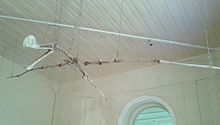脊頜翼龍屬
脊頜翼龍(學名:Tropeognathus,意為「有龍骨的顎」)是大型翼龍目的一個屬,來自早白堊世晚期的南美洲。該屬被視為古魔翼龍科成員之一,但也有研究將其歸入鳥掌翼龍科。這兩個科均是翼龍目中物種繁多的類群,以吻尖有龍骨的吻部及巨大體型而聞名。脊頜翼龍被視為南半球發現的最大翼龍,僅有龐大的神龍翼龍科才能與之匹敵。[1]模式種兼唯一種是南方脊頜翼龍(Tropeognathus mesembrinus)。脊頜翼龍化石遺骸發現於巴西東北部阿勒萊皮盆地桑塔納組的羅穆阿爾多組化石群。[2]
| 脊頜翼龍屬 | |
|---|---|

| |
| 巴西國家博物館的骨骼重建 | |
| 科學分類 | |
| 界: | 動物界 Animalia |
| 門: | 脊索動物門 Chordata |
| 綱: | 蜥形綱 Sauropsida |
| 目: | †翼龍目 Pterosauria |
| 科: | †鳥掌翼龍科 Ornithocheiridae |
| 屬: | †脊頜翼龍屬 Tropeognathus Wellnhofer, 1987 |
| 模式種 | |
| †南方脊頜翼龍 Tropeognathus mesembrinus Wellnhofer, 1987
| |
| 異名 | |
發現與命名
編輯20世紀80年代,德國慕尼黑的巴伐利亞收藏古生物學與歷史地理學博物館(Bayerische Staatssammlung für Paläontologie und historische Geologie)從巴西化石商人手中得到一個翼龍顱骨,其可能是從巴西塞阿拉州阿勒萊皮盆地(查帕達杜阿勒萊皮)一處稱作桑塔納群的地質單元中發現的。[3]彼得·韋爾恩霍費爾(Peter Wellnhofer)於1987年將其命名並描述為模式種南方脊頜翼龍(Tropeognathus mesembrinus)。屬名取自τρόπις/tropis(龍骨)及γνάθος/gnathos(顎)。種名取自通用希臘語mesembrinos(正午的,引申為「南方的」),指化石出土於南半球。[3]
正模標本BSP 1987 I 46發現於桑塔納群羅穆阿爾多組的一層中,地質年齡介於阿普第階最末期與阿爾布階最早期之間。除正模標本外,該化石遺址還發現了其它幾件翼龍標本,然而這些標本均被歸入古魔翼龍和西阿翼龍等幾個屬。[4][5]正模標本包含一個帶有下頜的顱骨。安德烈·雅各·韋德梅傑爾(André Jacques Veldmeijer)於2002年歸入了第二件標本:SMNS 56994,由部分下頜骨組成。[6]2013年,巴西古生物學家亞歷山大·克爾納(Alexander Kellner)歸入了體型更大的第三件標本:MN 6594-1,為一具帶有顱骨的骨骼,包括除尾部及後肢外來自全身各部位的大量材料。[7]
自從1987年韋爾恩霍費爾命名南方脊頜翼龍後,其他研究者均傾向於將其歸入其它幾個屬,引發了大量分類爭議。[8]其於1989年被克爾納改為南方古魔翼龍(Anhanguera mesembrinus)、[9]於1998年被韋德梅傑爾改為南方槌喙龍(Criorhynchus mesembrinus)、於2001年被米高·斐斯奈克特(Michael Fastnacht)改為南方殘喙翼龍(Coloborhynchus mesembrinus)。[10][11][7]後來大衛·安文(David Unwin)將脊頜翼龍材料歸入扁鼻鳥掌翼龍(Ornithocheirus simus),使南方脊頜翼龍成為前者的次異名,並於2003年更名為南方鳥掌翼龍(Ornithocheirus mesembrinus)。[12][13]韋德梅傑爾於2006年支持脊頜翼龍與鳥掌翼龍是同一個屬,但反對扁鼻鳥掌翼龍(O. simus)而贊成扁喙鳥掌翼龍(O. compressirostris)成為鳥掌翼龍的模式種,後者由安文根據英國古生物學家雷金納德·沃爾特·霍利(Reginald Walter Hooley)1914年的一項分析而命名為槍嘴翼龍。[14][15]韋德梅傑爾因此使用了扁鼻槌喙龍(Criorhynchus simus)及南方槌喙龍(Criorhynchus mesembrinus)等名稱。[2]然而,泰莎·羅德里格斯(Taissa Rodrigues)與亞歷山大·克爾納於2013年得出結論,認為脊頜翼龍是有效屬且僅含模式種南方脊頜翼龍一個種。[7]
時間回到1987年,當時韋爾恩霍費爾已根據標本BSP 1987 I 47——一塊更粗壯的下頜骨命名了第二個種,稱作強壯脊頜翼龍(Tropeognathus robustus)。[3]然而,強壯脊頜翼龍於2013年被視為古魔翼龍的一個種並改名為強壯古魔翼龍(Anhanguera robustus)。[7]
描述
編輯體型
編輯已知脊頜翼龍翼展長達8.26米(27.1英尺)左右,這一點可從標本MN 6594-1的巨型尺寸中推斷出來。[1]脊頜翼龍最大翼展估計高達8.70米(28.5英尺),略高於該屬平均估計值,但遠大於其他近親如鳥掌翼龍及殘喙翼龍,後者翼展一般估計在4.5至6.1米(15至20英尺)之間。[7]出土的一個殘喙翼龍顱骨長度粗測為75厘米(30英寸),據此得出的翼展估計為7米(23英尺),大於該屬平均估計值,但仍小於脊頜翼龍估計值。然而該標本被認為屬於其它屬,儘管在幾項研究中,一些古生物學家稱之為大頭殘喙翼龍(Coloborhynchus capito),而在1870年時英國古生物學家哈利·絲萊(Harry Govier Seeley)最初則稱之為大頭鳥掌翼龍(Ornithocheirus capito)。[16][17]
顱骨與頭冠
編輯脊頜翼龍顱骨在其吻部及下頜底側生有凸起的獨特「龍骨狀」嵴飾,該嵴突出、發育良好且相對較大,尤其是在雄性中,但與鳥掌翼龍等其它近親相比較薄而非更厚。[2]上嵴從吻尖向後延伸至鼻眶前孔(fenestra nasoantorbitalis)即顱骨側面的較大開口。一隻額外的較小嵴自下頜骨聯合(「下巴」區域)向下突出。[14]一種與之類似的古魔翼龍科——古魔翼龍屬具有寬度逐漸變窄的頜骨,但在尖端擴張為寬闊的勺形玫瑰狀結構。吻尖與脊頜翼龍的區別在於形狀更窄。[18]頜骨可根據頭冠上的大量差異從近親中鑑別出來:與近親殘喙翼龍和鳥掌翼龍不同,上頜頭冠更大、更突出,因此顱骨會更寬。[1]
椎骨
編輯脊頜翼龍前五節背椎融合成聯合背椎,五節骶椎融合成聯合骶椎,其中第三及第四節具有龍骨。髂骨前刃強烈上彎形成狹窄結構。[1]
分類
編輯韋爾恩霍費爾於1987年將脊頜翼龍歸入脊頜翼龍科。[3]其它研究並未採用這一概念;幾名研究者將南方脊頜翼龍與古魔翼龍一起歸入古魔翼龍科,其它系統發育分析則將脊頜翼龍歸入鳥掌翼龍科作為其原始成員,這表明其與鳥掌翼龍的親緣關係近於古魔翼龍。後一概念主要為歐洲研究者採用,他們更傾向於將鳥掌翼龍科而非古魔翼龍科用作泛圍最廣的分類群。[13]安德列斯與邁爾斯2013年的拓撲將脊頜翼龍置於鳥掌翼龍科一處較鳥掌翼龍更原始的位置,該科本身則是處於泛圍更廣的鳥掌翼龍類演化支中。[19]然而,2019及20年的許多後期研究均發現脊頜翼龍隸屬古魔翼龍科,[20][21][22]其中較特殊的一項是由博里亞·霍爾加多(Borja Holgado)與羅德里格·佩加斯(Rodrigo Pêgas)於2020年所作,將脊頜翼龍更確切地歸入脊頜翼龍亞科作為焚風翼龍的姐妹群。[23]
|
拓撲1:安德列斯與邁爾斯(2013年)。[19]
|
拓撲2:霍爾加多與佩加斯(2020年)。[23]
|
流行文化
編輯英國廣播公司(BBC)獲獎電視節目《與恐龍同行》有一整集的主題都是南方脊頜翼龍(其中將脊頜翼龍冠以近親鳥掌翼龍之名,並誤稱為南方鳥掌翼龍)。[14]該系列的配套書籍《與恐龍同行:自然史》(Walking with Dinosaurs: A Natural History)中聲稱巴西桑塔納群(書中稱為桑塔納組)的幾塊碩大骨頭碎片表明,南方鳥掌翼龍翼展可能長達將近12米(39英尺)、重100公斤(220英磅), 使之成為已知最大的翼龍之一。[25]然而,當時描述的南方鳥掌翼龍最大已確認標本翼展測為6米(20英尺)。[8]節目製作人用以證明龐大體型估計的標本於2012年被描述,在《與恐龍同行》製作期間,大衛·馬提爾與大衛·安文正在研究這些標本。遺骸最終描述中估計這個巨型標本的最大翼展為8.70米(28.5英尺)。安文表示,他不相信BBC使用的更高估計值是可能的,製片方貌似選擇了可能的最高估計值因為它更「壯觀」。[26]然而,2013年發現的標本MN 6594-V從完整程度上講是已知最大的翼龍個體。[1]
參見
編輯參考資料
編輯- ^ 1.0 1.1 1.2 1.3 1.4 Kellner, A. W. A.; Campos, D. A.; Sayão, J. M.; Saraiva, A. N. A. F.; Rodrigues, T.; Oliveira, G.; Cruz, L. A.; Costa, F. R.; Silva, H. P.; Ferreira, J. S. The largest flying reptile from Gondwana: A new specimen of Tropeognathus cf. T. Mesembrinus Wellnhofer, 1987 (Pterodactyloidea, Anhangueridae) and other large pterosaurs from the Romualdo Formation, Lower Cretaceous, Brazil. Anais da Academia Brasileira de Ciências. 2013, 85 (1): 113–135. PMID 23538956. doi:10.1590/S0001-37652013000100009 .
- ^ 2.0 2.1 2.2 Veldmeijer, A.J. Toothed pterosaurs from the Santana Formation (Cretaceous; Aptian-Albian) of northeastern Brazil. A reappraisal on the basis of newly described material. 2006. (原始內容存檔於2012-03-17). Tekst. – Proefschrift Universiteit Utrecht.
- ^ 3.0 3.1 3.2 3.3 Wellnhofer, Peter. New crested pterosaurs from the Lower Cretaceous of Brazil. Mitteilungen der Bayerische Staatssammlung für Paläontologie und historische Geologie. 1987, 27: 175–186.
- ^ Pinheiro, F.L.; Rodrigues, Taissa. Anhanguera taxonomy revisited: is our understanding of Santana Group pterosaur diversity biased by poor biological and stratigraphic control?. PeerJ. 2017, 5: e3285. PMC 5420195 . PMID 28484676. doi:10.7717/peerj.3285.
- ^ Leonardi, G.; Borgomanero, G. Cearadactylus atrox nov. gen., nov. sp.: novo Pterosauria (Pterodactyloidea) da Chapada do Araripe, Ceara, Brasil. Resumos dos communicaçoes VIII Congresso bras. de Paleontologia e Stratigrafia. 1985, 27: 75–80.
- ^ Veldmeijer, A.J. Pterosaurs from the Lower Cretaceous of Brazil in the Stuttgart collection. Stuttgarter Beiträge zur Naturkunde, Serie B (Geologie und Paläontologie). 2002, 327: 1–27.
- ^ 7.0 7.1 7.2 7.3 7.4 Rodrigues, T.; Kellner, A. Taxonomic review of the Ornithocheirus complex (Pterosauria) from the Cretaceous of England. ZooKeys. 2013, (308): 1–112. PMC 3689139 . PMID 23794925. doi:10.3897/zookeys.308.5559 .
- ^ 8.0 8.1 Wellnhofer, P. The Illustrated Encyclopedia of Pterosaurs. New York: Barnes and Noble Books. 1991: 124. ISBN 0-7607-0154-7.
- ^ Kellner, A.W.A. A new Edentate Pterosaur of the lower Cretaceous from the Araripe Basin, Northeast Brazil. Anais da Academia Brasileira de Ciências. 1989, 61: 439–446 [2023-09-09]. S2CID 89420181. (原始內容存檔於2022-07-02).
- ^ Veldmeijer, A.J. Pterosaurs from the Lower Cretaceous of Brazil in the Stuttgart Collection. Geoscience and Engineering. 1998, 327: 1–27 [2023-09-09]. (原始內容存檔於2023-05-22).
- ^ Fastnacht, M. First record of Coloborhynchus (Pterosauria) from the Santana Formation (Lower Cretaceous) of the Chapada do Araripe of Brazil. Paläontologische Zeitschrift. 2001, 75: 23–36. S2CID 128410270. doi:10.1007/bf03022595.
- ^ Unwin, D.M. An overview of the pterosaur assemblage from the Cambridge Greensand (Cretaceous) of Eastern England. Mitteilungen aus dem Museum für Naturkunde in Berlin, Geowissenschaftliche Reihe. 2001, 4: 189–221.
- ^ 13.0 13.1 Unwin, D. M. On the phylogeny and evolutionary history of pterosaurs. Geological Society, London, Special Publications. 2003, 217 (1): 139–190. Bibcode:2003GSLSP.217..139U. CiteSeerX 10.1.1.924.5957 . S2CID 86710955. doi:10.1144/GSL.SP.2003.217.01.11.
- ^ 14.0 14.1 14.2 Unwin, David M. The Pterosaurs: From Deep Time. New York: Pi Press. 2006: 246. ISBN 0-13-146308-X.
- ^ Hooley, Reginald Walter. On the Ornithosaurian genus Ornithocheirus, with a review of the specimens from the Cambridge Greensand in the Sedgwick Museum, Cambridge. Annals and Magazine of Natural History. 1914, 13 (78): 529–557 [2023-09-09]. ISSN 0374-5481. doi:10.1080/00222931408693521. (原始內容存檔於2023-03-24) (英語).
- ^ Martill, D.M.; Unwin, D.M. The world's largest toothed pterosaur, NHMUK R481, an incomplete rostrum of Coloborhynchus capito (Seeley 1870) from the Cambridge Greensand of England. Cretaceous Research. 2011. doi:10.1016/j.cretres.2011.09.003.
- ^ Seeley, H.G. The Ornithosauria: an Elementary Study of the Bones of Pterodactyles. Cambridge. 1870: 130 pp.
- ^ Kellner, A.W.A.; Tomida, Y. Description of a new species of Anhanguera (Pterodactyloidea) with comments on the pterosaur fauna from the Santana Formation (Aptian–Albian), northeastern Brazil. Tokyo, National Science Museum (National Science Museum Monographs, 17). 2000.
- ^ 19.0 19.1 Andres, B.; Myers, T. S. Lone Star Pterosaurs. Earth and Environmental Science Transactions of the Royal Society of Edinburgh. 2013, 103 (3–4): 1. S2CID 84617119. doi:10.1017/S1755691013000303.
- ^ Holgado, Borja; Pêgas, Rodrigo V.; Canudo, José Ignacio; Fortuny, Josep; Rodrigues, Taissa; Company, Julio; Kellner, Alexander W. A. On a new crested pterodactyloid from the Early Cretaceous of the Iberian Peninsula and the radiation of the clade Anhangueria. Scientific Reports. 2019, 9: 4940. doi:10.1038/s41598-019-41280-4.
- ^ Kellner, Alexander W. A.; Caldwell, Michael W.; Holgado, Borja; Vecchia, Fabio M. Dalla; Nohra, Roy; Sayão, Juliana M.; Currie, Philip J. First complete pterosaur from the Afro-Arabian continent: insight into pterodactyloid diversity. Scientific Reports. 2019, 9 (1): 17875. Bibcode:2019NatSR...917875K. PMC 6884559 . PMID 31784545. doi:10.1038/s41598-019-54042-z .
- ^ Pêgas, R.V.; Holgado, B.; Leal, M.E.C. Targaryendraco wiedenrothi gen. nov. (Pterodactyloidea, Pteranodontoidea, Lanceodontia) and recognition of a new cosmopolitan lineage of Cretaceous toothed pterodactyloids. Historical Biology. 2019: 1–15. doi:10.1080/08912963.2019.1690482.
- ^ 23.0 23.1 Holgado, B.; Pêgas, R.V. A taxonomic and phylogenetic review of the anhanguerid pterosaur group Coloborhynchinae and the new clade Tropeognathinae. Acta Palaeontologica Polonica. 2020, 65. doi:10.4202/app.00751.2020 .
- ^ 存档副本 (PDF). [2012-04-29]. (原始內容存檔 (PDF)於2021-01-13).
- ^ Haines, T. "Walking with Dinosaurs": A Natural History. BBC Books. 1999: 158.
- ^ Bredow, H.P. Re: WWD non-dino questions. Message to the Dinosaur Mailing List. 2000-4-18 [2011-1-20]. (原始內容存檔於2016-04-04).